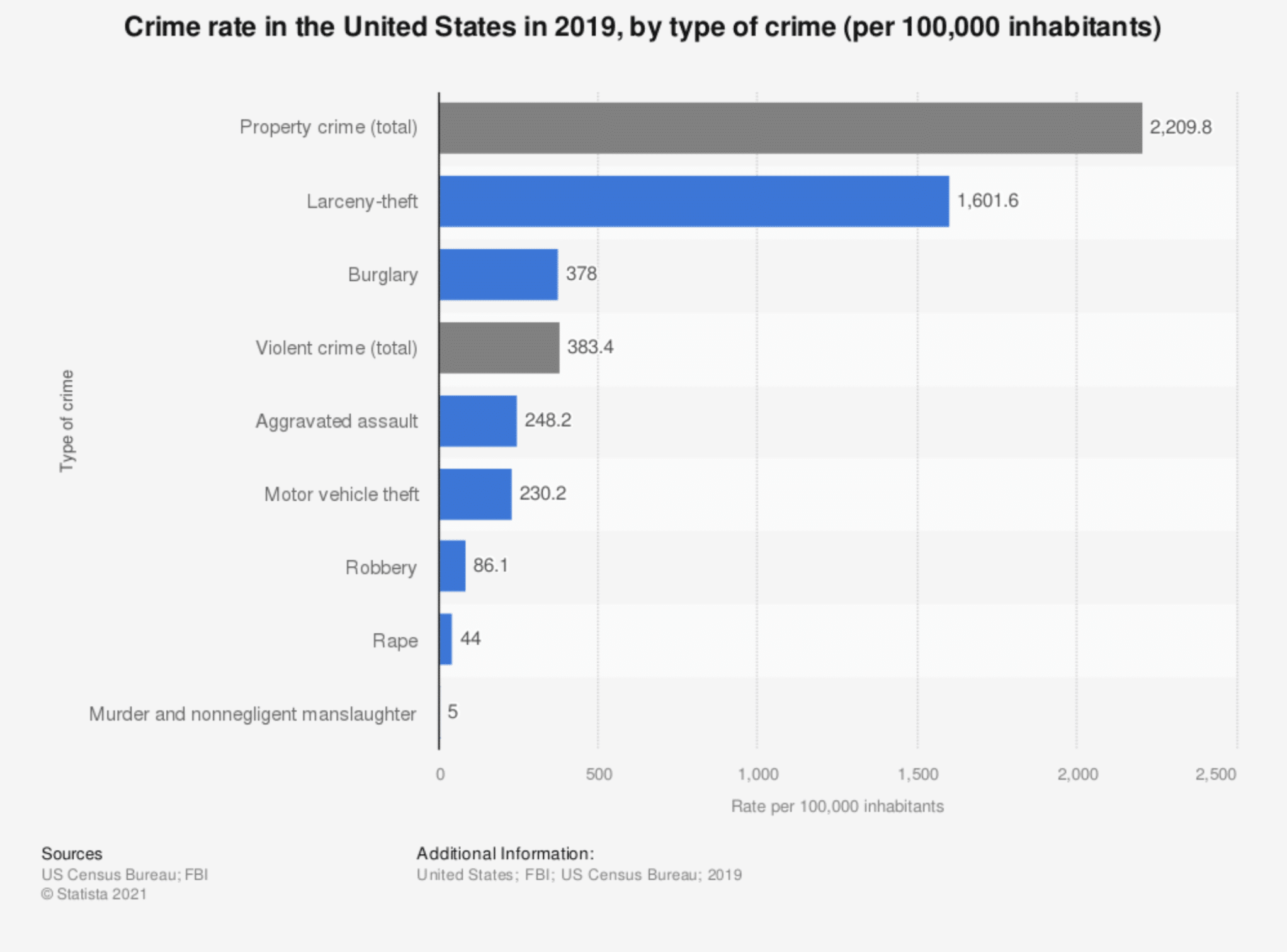The 5 Pillars of CPTED: Territorial Reinforcement
Read the paper or browse online, and there’s always some burglary or assault or other violent incident making news. It can feel like crime is an inescapable fact of life.
And while that may be true, the data paints a much more encouraging picture. Property and violent crimes have actually been decreasing for the past 30 years:
- There were 7,945,700 reported larceny-theft cases in the US in 1990, but only 4,606,324 in 2020.
- Violent crimes? They fell from 1,820,127 reported cases to 1,313,105 in that same time period.
- Burglaries dropped from just over three million to a little over one million 30 years later.
We tend to fixate on the negative, but those numbers don’t lie. Things are getting better.
Property crime—including larceny, motor vehicle theft, and burglary—is nearly 6x more prevalent than violent crime, so it still makes sense to protect your home, business, and property.

It stands to reason that property crime (20%) is listed as the #1 safety concern, followed by violent crime (18%) and the COVID pandemic (17%) in the top three.
Locked doors, closed windows, and exterior lighting are a good place to start, but it’s wise to do more than just the minimum.
According to a survey of 15,000 Americans, security cameras are the preferred tactic, ranking higher than firearms, security alarms, and guard dogs.
Another strategy recommended by more and more law enforcement and security personnel is crime prevention through environmental design, or CPTED.
The Pillars of CPTED
Through its five overlapping pillars, CPTED is the use of intentional design elements that work together to discourage criminal behavior before it happens:
- Natural Surveillance
- Natural Access Control
- Territorial Reinforcement
- Activity Support
- Maintenance
You’ve likely seen CPTED in the real world without even realizing it. Keeping hedges no higher than four feet so people can see your house? That’s an example.
Clearly identifying your territory? That’s another, and the third pillar of CPTED itself.
Territorial Reinforcement
On the whole, most people are law-abiding citizens and respect the property of others.
If I know this is your territory, I won’t treat it as mine. And if everyone knows it’s your territory, they’ll be suspicious of anyone else using it.
And that’s the idea behind territorial reinforcement: make it clear that an area is owned and cared for by someone.
Picture this: two homes, side by side. Both occupied.
The first has a manicured front yard, a carefully-tended garden, and a white picket fence around the perimeter.
The second has an overgrown lawn, dead flowers, and no fence.
Which one is more appealing to a would-be criminal? The first might have better things, but we can’t say that for sure. The only thing we know is that one is cared for, and the other is not.
And if the occupants don’t care for it, they might not be interested in protecting it with locks, cameras, or alarms. It’s an easier target in that sense.
Territorial reinforcement sends cues out to the world declaring that this is your space. It is not a public space. And you will defend and protect it.
The image above shows territorial reinforcement with the iron fence clearly separating public and private space (as well as the groomed and debris-free lawn), natural access control (preventing people from wandering in for whatever reason), and natural surveillance (by keeping the fence low and see-through).
Territorial Reinforcement in the Real World
Take a look from the outside of your home or business. What do you see? Does it look owned and cared for? Or does it look abandoned, unkept, and ignored?
One will give criminals pause, while the other will attract them. You want by-passers to see instantly that someone is present in the space, looks after it, and cares what happens to it.
Territorial reinforcement works on two fronts:
- It creates a stronger sense of ownership and vested interest in the property
- It creates greater awareness among your neighbors and pedestrians of where people should and should not be, and what they should and should not be doing
A sign saying “No Soccer” in a public park is an example of territorial reinforcement. It enforces the idea that no one should be playing soccer there, so people are more prone to notice if someone does it.
Likewise, an individual climbing over a fence is obviously violating that territory to anyone who happens to see it.
You can accomplish territorial reinforcement via:
- Landscaping, which shows an active presence and often provides some level of access control
- Walkways guide users along acceptable paths and keep them from private spaces
- Lighting can eliminate dark corners and blind spots where criminal activity might take place, while also presenting a vibrant, occupied territory
- Signs can quickly and easily designate territory (no entry, no trespassing, no loitering) and acceptable usage (no parking, no hockey, residents only)
- Fences—when kept see-through and low to the ground—provide not only territorial reinforcement but also natural surveillance and access control
- Clearly marked boundaries of private, semi-private, and public space via signage, change of material (e.g. asphalt to grass), painted lines, posts, shrubbery, flowers, or any other visual cue
- Well maintained appearance
- Security cameras or other security measures are perhaps the strongest cues that a territory is owned, cared for, and well-defended
The Three Ds
Timothy Crowe talks about the Three-D approach to territory assessment:
- All human space has some designated purpose
- All human space has social, cultural, legal, or physical definitions that prescribe the desired and acceptable behaviors
- All human space is designed to support and control the desired behaviors
So ask yourself: what is the designated purpose of this space? How is it defined? Who owns it? Are there signs and clear borders? How well does the physical design support the intended purpose?
Your backyard, for example, is designated for the enjoyment of you, your family, and invited guests. A fence or low shrubbery around the perimeter makes that clear to everyone else, whereas the lack of clear borders may lead to confusion or invite unwanted guests.
At its simplest, territorial reinforcement is taking deliberate steps to make it abundantly clear that your property is your property, that you’re an active presence in the space, and that you will protect it from all intruders.
Need a Solution that Prevents Crime?
Deep Sentinel is the only security technology that delivers the experience of a personal guard on every customer’s home and business. Visit deepsentinel.com/business or call 833-983-6006

